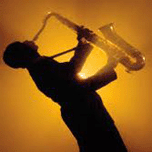The Seductive Enigma of Jazz

Trying to write about Jazz is a bit like trying to paint Connemara. In both instances the subject is so elusive that to describe it conclusively on either paper or canvas is nigh near impossible and the writer or artist is reduced to focusing on an individual moment that most responds to or echoes their personal or artistic talent. In both cases this is due to their elemental nature and their absolute refusal to be artificially moulded into a definite entity. When Jazz began to evolve from its multifarious foundations and make itself felt as the powerful music force it now is,
it was deemed to be a grossly irrelevant, noisy and vulgar expression with absolutely no aesthetic value of an ignorant, illiterate and downtrodden people and deserving of nothing but the utmost contempt.
But the spirit of Jazz was resilient and, despite being constantly marginalised, its performance and influence grew in stature to become one of the fundamental genres of modern music, a fact that suggests it expresses the spiritual essence of the human heart and soul. (One of the reasons why Louis Armstrong loved Paris so much when he first visited it in the early 30s was that it was there that he was first referred to as being an Artist rather that an Entertainer.)
And like all things that touch the heart and soul, Jazz defies definition or even description. It oscillates between the Big Band performance of a Count Basie or a Duke Ellington to the sole and anonymous musician or singer alone in the dark corner pouring out their heart and soul as much to themselves as to anybody who cares to listen.
Within these extremely loose limits, the punter can explore the full range of human joy and suffering from the exuberance of Louis Armstrong or Lionel Hampton to the extraordinary dignified and individual expression of human tragedy in Carmen Mc Crae’s version of “Miss Otis Regrets”. The real beauty, and indeed excitement, of this is that Jazz is a never ending changing river of emotion obeying no rules except those of an individual heartfelt expression of the spiritual or mundane human experience. The punter, and sometimes the musician or singer, never knows what is coming next.
My first experience of Jazz was trying hard to catch the strains and melodies of Acker Bilk and Kenny Ball outside Seapoint Ballroom (which I believe also hosted Chris Barber) when these two great artists played the famous Salthill venue sometime during the early Sixties, being too young and not having either them money or the know how to get inside.
Throughout the Seventies and Eighties and indeed into the Nineties, the Jazz Scene in Galway, insofar as my experience of it went, was dominated by that wonderful band “All That Jazz”, consisting mainly of the various members of the Dooley family. One of the highlights of the first Streets Festival in celebrating Galway’s Quincentenary in 1984, was the open air concert they gave as they blasted out their own particular brand of Dixieland to the seething bopping sea of people that were literally jammed into Quay Street.
After that, my interest in and knowledge (such as it was) of Jazz waned being reignited by a chance purchase in, of all places, Schiphol Airport. Meanwhile the Galway Jazz Scene had grown to such an extent that a number of years ago the first Galway Jazz Festival took place. Now in its Eighth year, the Festival has thrived and, because of this, Jazz has spread gradually, if somewhat slowly, to all parts of the city and county.
In Salthill, five years ago, the Bal hosted a Jazz session every Sunday evening from seven to eight p.m. for a number of summers. More recently, further down the Village, a Restaurant Wine and Tapas Bar called The Black Cat quietly opened its doors. It is only when you are inside the door you realise that the staple menu of this sophisticated venue is Jazz and that there are many wonderful sessions held there during the week without comment, without fanfare so that along with the wonderful food and wine, the punter can also sit, listen and relax in what has to be the best kept Jazz secret in town.
With venues like this, there is hope for us all and if the Galway Jazz Festival continues to inspire others to open similar oases such as The Black Cat, it will have added immeasurably to the cultural life of the city.
